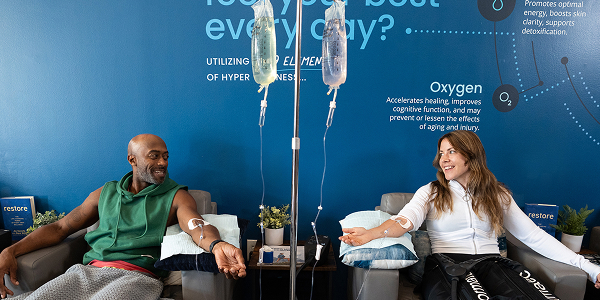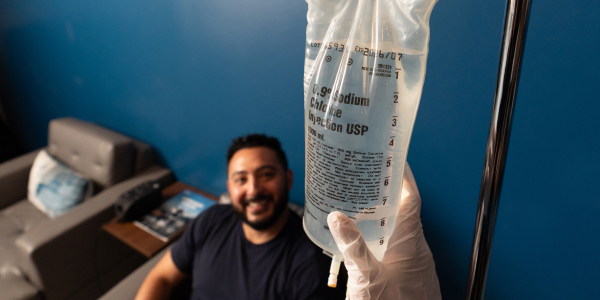It is a fundamental principle in life that improvement almost always requires a certain degree of discomfort.
Exercise is one of the best examples of this. When you engage in intense physical activity, your body is subjected to a barrage of stressors. Your muscle fibers are damaged, and you're stiff and sore the next day as a result. But if you do the same workout a week later, it's usually easier, and you don't need as much downtime. That's because after the hard workout, various cellular pathways were activated to rebuild your muscles and enable your body to withstand greater stress in the future. This is how we get bigger, faster, and stronger.
We are starting to realize that certain other forms of stress can trigger adaptations that are quite similar to exercise. One example is heat exposure. In fact, the physiological responses produced by a session in the sauna correspond remarkably closely to those produced by aerobic exercise. For instance, in a single sauna session, your heart rate can go up to 150 beats per minute - not unlike a workout! This is why some scientists became interested in passive heat exposure as a possible exercise mimetic for people who have a hard time being active.
But emerging research suggests that sauna bathing (a form of passive heat therapy that is characterized by exposure to high environmental temperature for a brief period) may do even more than that. In fact, using the sauna on a regular basis has been shown to enhance aerobic capacity in trained athletes, resulting in measurable performance improvements. Here’s how it works.
Basic responses to heat
When you're exposed to heat, you start to sweat. Obviously. But where specifically does that sweat come from? The water content of sweat comes from plasma - the liquid component of your blood, minus the red blood cells.
To make that happen, much of your body's circulation is shuttled away from the core and toward your skin. More blood flow to the skin helps provide a nice reservoir of fluid for producing sweat (sounds kind of gross I know). And then, as that sweat evaporates, heat is removed from the surface, helping cool you off.
But this elegant physiological process presents a problem. It means that you're losing core blood volume as you sweat, and if that were to persist, your core body temperature would go up and you would be cooked. Literally.
No bueno.
Fortunately, the body is highly adaptable. Continued heat stress causes the blood vessels to dilate, increasing blood flow and boosting total plasma volume. But maybe most importantly, repeated heat exposure results in a sustained expansion in plasma volume, to accommodate future thermal challenges, and this is where things start to get super interesting from an exercise performance standpoint.
Why you want more blood
Bear in mind that more than half of your blood is made up of plasma. So more plasma, in effect, means more overall blood volume coursing through your body.
Here's why this is advantageous for you: Think about one of those squeeze bottles, like what you'd use for ketchup or dressing. It's a whole lot easier to push the condiment out when the bottle is almost full, right? When there is less in there, you have to squeeze harder, or shake it, and generally have to exert more force to release the same amount (yeah I know, this is a weird analogy, bear with me here).
It's kind of the same thing with your heart and blood vessels. If you have a greater total blood volume, that means that every time your heart beats, it can now pump more blood with less effort, efficiently sending oxygen and other nutrients to your muscles and other tissues. That, in turn, results in a lower heart rate and less cardiovascular strain for the same workload.
In effect, you are equipped with a more powerful aerobic engine.
And this increase in plasma volume, in response to heat exposure, can happen fast.
Researchers in Australia wanted to see how exposure to heat, via sauna, could affect plasma volume in trained athletes. So they took seven cyclists and monitored their normal training for a couple of weeks. Then, they had the athletes add in 30 minutes of sauna immediately after their training sessions.
After just four sauna sessions, these athletes experienced a 17.8% expansion of their peak plasma volume, compared to where it was during their normal training.
That is pretty impressive, but there are a couple things to keep in mind here. First of all, this was a very short study, only looking at ten total days of sauna use, and that pronounced expansion in plasma volume started to recede in the last few days of the study period. Additionally, they didn't look at how the sauna sessions affected aerobic performance.
So this raises a couple of questions: Is that boost in blood volume just a short term thing? And does it necessarily translate to increased exercise performance?
Blood doping - the natural (and safe) way
If you continue to regularly use the sauna, your plasma volume remains higher than before, but it does seem to go back down a bit over time. However, something else starts to happen, which might be even better for a hard-charging athlete: your body starts to generate more red blood cells.
To gain insight into this process, a team of researchers in New Zealand conducted a small study in which they took six well-trained distance runners and had them do one three week period of normal training, and one three week period of training plus sauna bathing. In the sauna group, the sauna bathing was performed immediately post-exercise, for 30 minutes. After each three week period, the researchers made the participants run on a treadmill (at a pace based on their fastest 5K time) until they were totally exhausted and couldn’t run any longer.
So what happened?
Well, sauna bathing led to a 7.1% increase in plasma volume - as well as a 3.5% increase in red blood cell volume. This may be due to a decrease in blood flow to the kidneys during heat exposure, which triggers them to release erythropoietin (aka EPO), a hormone that stimulates production of red blood cells. More red blood cells means boosted cardiac output, and facilitates the delivery of oxygen to working skeletal muscles. So, again, this is something we want.
But what was really mind-blowing here was how that increased blood volume translated to their performance. When the runners were doing the sauna bathing, they were able to keep running at the speed of their fastest 5K time for 32% longer than before - cutting down on their 5K race time by almost 2%.
Putting it into practice
I always say that if you want to reap the same benefits observed in a given study, the smartest thing to do is to try to replicate the protocol that the researchers used.
In these experiments, the athletes generally used the sauna for about 30 minutes, right after training, and that seems like a reasonable approach. You will probably want to start with shorter bouts, like maybe five to ten minutes at first, and then work up to longer sessions. It might be tough at first, but it should get easier the more that you do it.
Incidentally, these studies were testing traditional saunas, but if you’d like to experiment with infrared saunas, as well as other performance-enhancing modalities, I’d encourage you to pay a visit to a Restore location near you.






